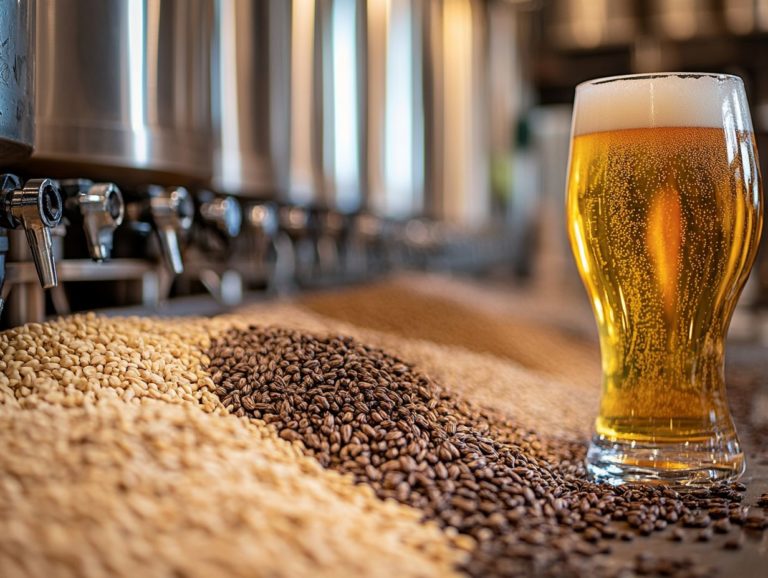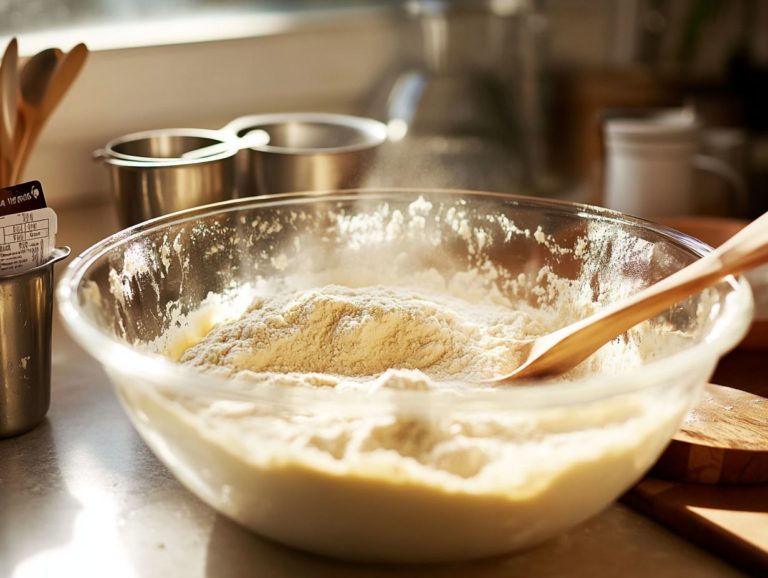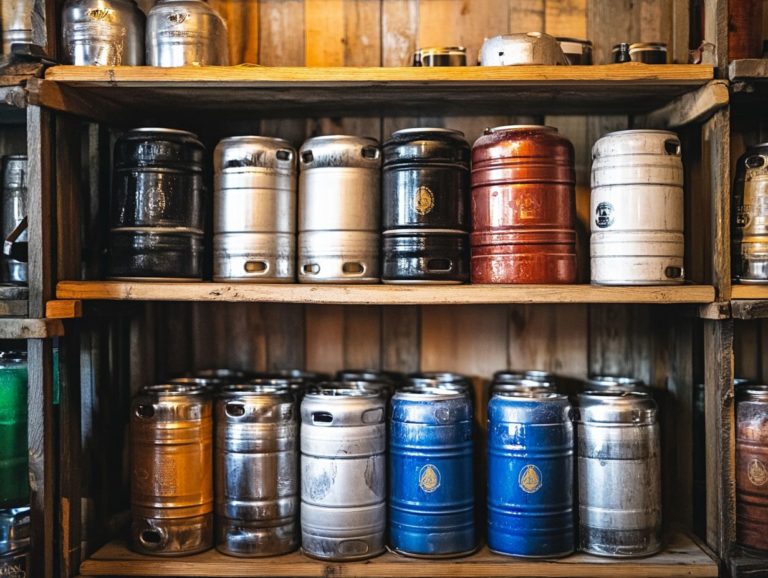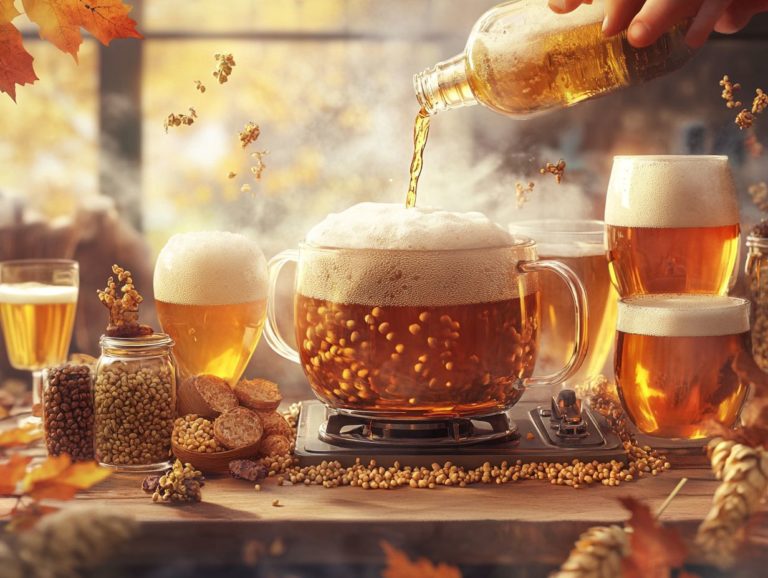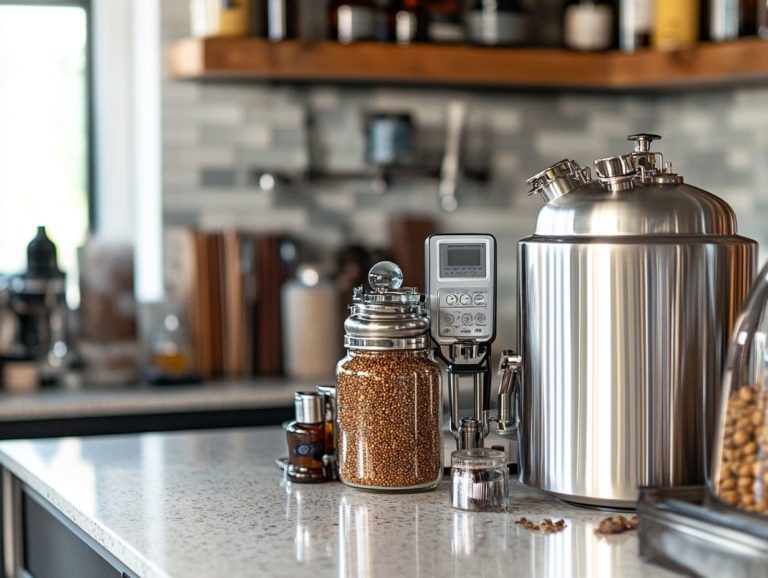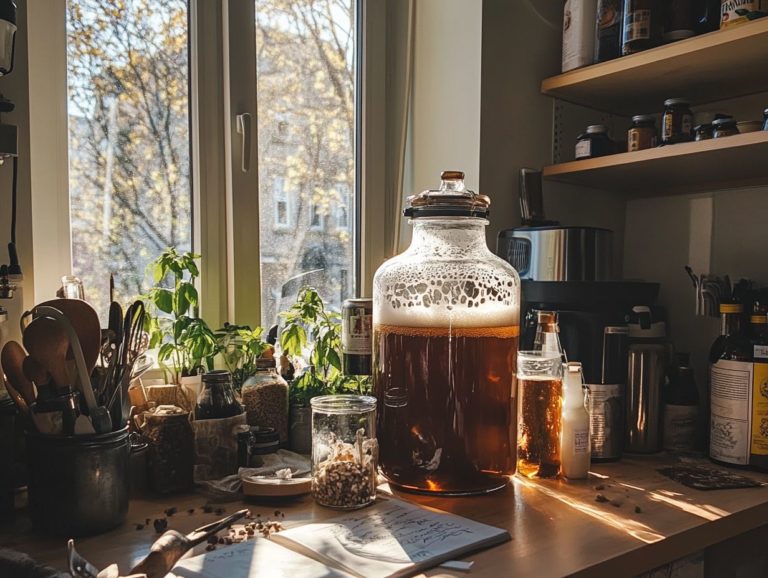How Do I Troubleshoot Off-Flavors?
Unexpected off-flavors can transform a delightful meal or beer into a rather disappointing experience. To truly elevate your culinary skills and brewing techniques, it s essential for you to understand the causes behind these undesirable tastes.
This article delves into the origins of off-flavors, guides you on how to identify them, and pinpoints the most common offenders that could be hiding in your pantry or brewing setup. It also provides practical tips to prevent these flavors and effective solutions to fix them when they arise. Dive in and troubleshoot your culinary and brewing creations to reach perfection!
Contents
- Key Takeaways:
- What Causes Off-Flavors in Food?
- How to Identify Off-Flavors?
- How to Prevent Off-Flavors?
- What Are the Best Practices for Preventing Off-Flavors?
- How to Fix Off-Flavors?
- What Are Some Common Solutions for Off-Flavors?
- How to Troubleshoot Specific Off-Flavors?
- 1. Rancid (Oxidized Fats/Oils)
- 2. Metallic (Leaching Metals)
- 3. Sour/Acidic (Unwanted Acids)
- 4. Bitter
- Common Off-Flavors in Brewing
- Frequently Asked Questions
- What are Off-Flavors?
- How do I identify Off-Flavors?
- What are Common Causes of Off-Flavors?
- How can I Troubleshoot Off-Flavors in My Food or Drink?
- Can Off-Flavors, Such as Those from Skunked Beer or Infections, Be Prevented?
- When Should I Seek Professional Help for Flavor Issues?
Key Takeaways:
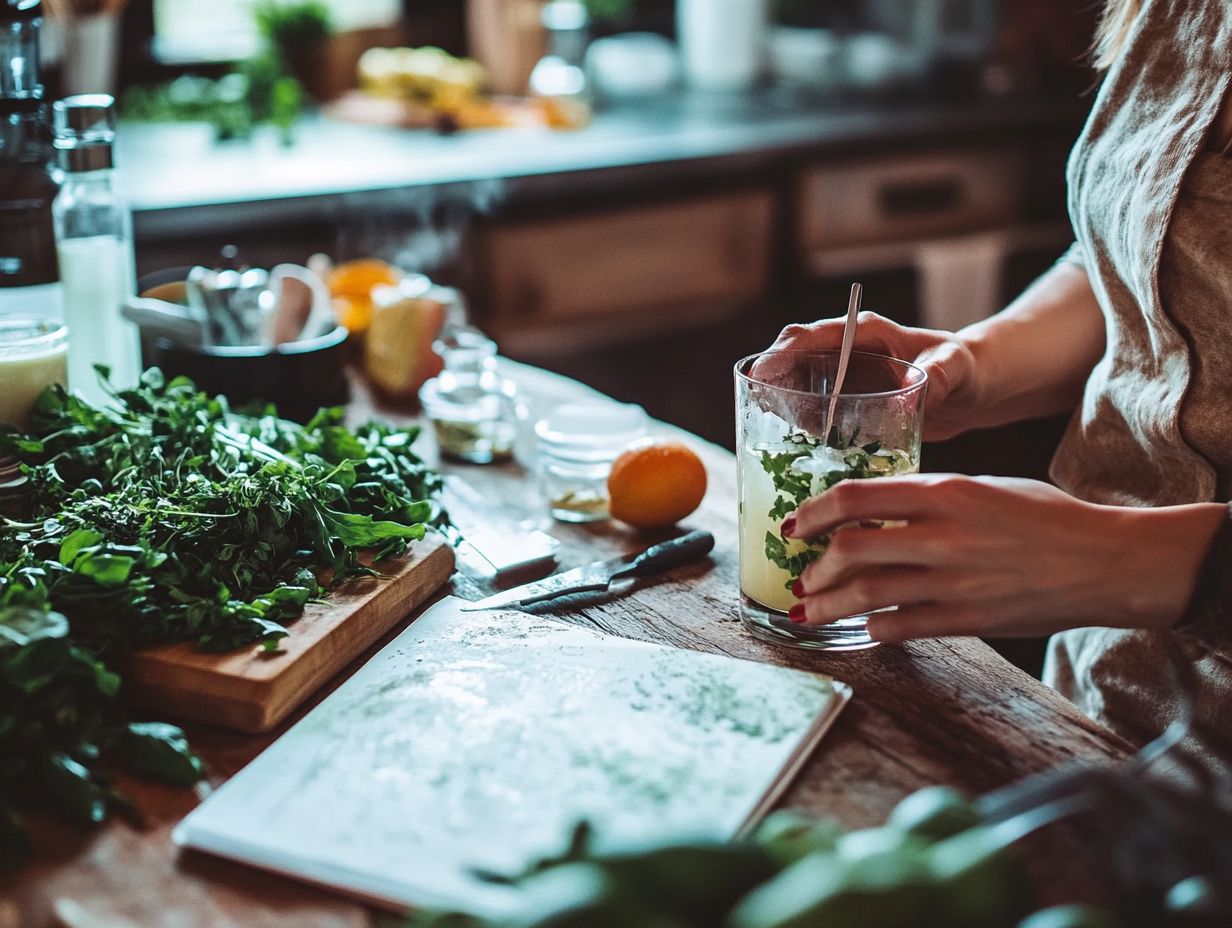
- Identify off-flavors in food and beer by using your senses and understanding the most common off-flavors such as skunked, acetaldehyde, and diacetyl.
- Prevent off-flavors by following best practices such as proper storage, using fresh ingredients, and avoiding cross-contamination.
- Troubleshoot specific off-flavors by knowing their characteristics and using appropriate solutions such as adding citrus for sour flavors or using a metal-free container for metallic flavors.
What Causes Off-Flavors in Food?
Off-flavors in food and beer can arise from numerous factors, such as inadequate sanitation, fermentation conditions, temperature variations, and the unwelcome presence of certain bacteria. These elements can dramatically shift the flavor profile of your food, resulting in undesirable tastes that compromise the overall quality of the final product.
Understanding the underlying causes of these off-flavors is essential for both food producers and home cooks. It enables you to exert greater control over your brewing and cooking processes. Whether it’s a microbial infection or the use of incorrect yeast strains, understanding these flavor issues is a vital part of preserving food quality.
How to Identify Off-Flavors?
To identify off-flavors in food and beer, you need good taste and a solid grasp of the flavors that should be present. It’s essential to understand the intricacies of the fermentation process and the common flavor profiles linked to specific ingredients and practices.
Your ability to pinpoint these nuances will elevate your culinary expertise and enhance your appreciation for the art of food and brewing.
What Are the Most Common Off-Flavors?
Be aware of several common off-flavors in food and beverages that can affect your brewing or food production, including skunked, acetaldehyde, and diacetyl. Each of these off-flavors results from specific processes or contaminations that can compromise your product’s quality.
Understanding these off-flavors is essential for maintaining the consistency and excellence of what you produce. Skunked flavors, primarily caused by light exposure, occur when the sensitive compounds in hops react chemically. This leads to a distinct skunky aroma that can ruin an ale’s profile, which is certainly not ideal.
Acetaldehyde, often likened to the scent of green apples, typically surfaces during fermentation when yeast is under stress or not managed properly. This can introduce undesirable characteristics into your brew. Then there’s diacetyl, notorious for its buttery flavor, which is usually produced by yeast and certain bacteria during fermentation, particularly when they linger too long in contact with their byproducts.
Recognizing and addressing these issues early in the brewing process is crucial for delivering a balanced and enjoyable final product.
For brewers, organizations like BJCP provide guidelines to help you understand and manage these off-flavors better.
How to Prevent Off-Flavors?
To ensure the highest quality in food and beverages, it is crucial to prevent off-flavors. You can achieve this through various methods:
- Implement stringent sanitation practices using products like Star San.
- Exercise meticulous temperature control during fermentation.
- Select the most suitable yeast strains for your specific needs.
Employing a fermentation fridge can also help maintain optimal temperatures during the brewing process.
What Are the Best Practices for Preventing Off-Flavors?
Implementing best practices in brewing and food preparation is essential for preventing off-flavors. This includes adhering to stringent sanitation procedures, exercising precise temperature control, and carefully monitoring fermentation processes.
Maintaining regular cleaning schedules for your equipment is crucial. Even the tiniest residues can introduce unwanted flavors into your brew. The importance of using clean, filtered water cannot be overstated, as impurities can significantly impact the taste profile of your final product.
Ingredient selection is equally vital. Opting for fresh hops from suppliers like IREKS and Weyermann can enhance aromatic qualities, whereas stale ingredients may leave your creation tasting dull or peculiar. Embracing techniques such as cold crashing a method used to clarify your brew by lowering the temperature before fermentation ends can help reduce the risk of grassy or off-flavors.
Proper yeast management with strains like Lallemand Diamond Lager ensures healthy fermentation, steering clear of unwanted esters or phenols.
How to Fix Off-Flavors?
Correcting off-flavors in food and beverages can indeed be a formidable task, yet you have a wealth of solutions at your disposal to mitigate these undesirable tastes.
Adjust your fermentation techniques, employ targeted chemical treatments, or revisit your sanitation processes. Each of these strategies offers a pathway to enhance the overall quality and enjoyment of your products.
The use of high-quality malt, such as Vienna Malt, can also make a significant difference in flavor development, minimizing off-flavors.
What Are Some Common Solutions for Off-Flavors?
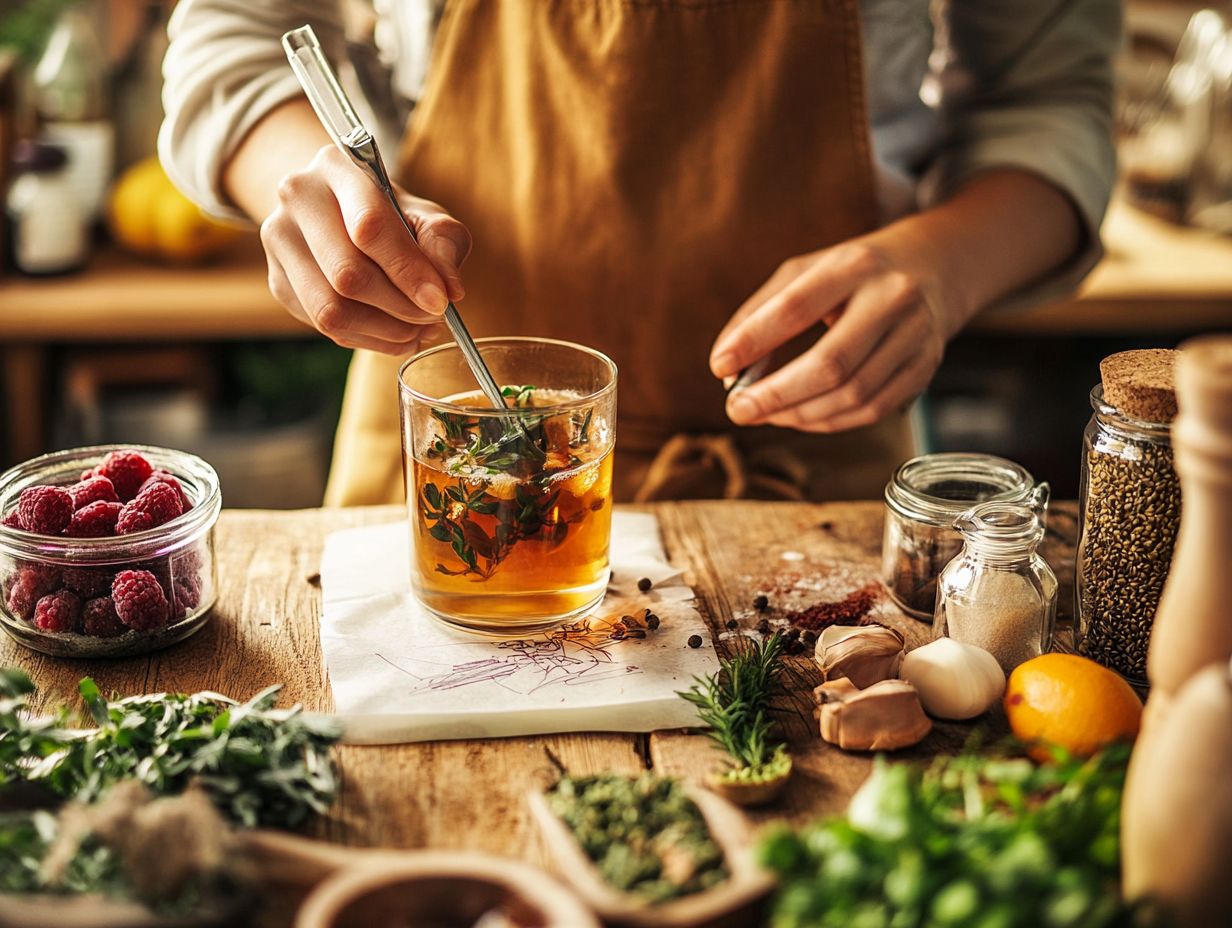
To tackle off-flavors effectively, adjust your fermentation conditions, select specific yeast strains, and implement careful cleaning methods to eliminate any sources of infection and contamination.
These strategies are paramount for anyone committed to achieving optimal quality in their beverages. By modifying fermentation temperatures, you can enable yeast to function more efficiently and minimize the chances of unwanted esters or phenols that might detract from your desired flavor profile. Choosing particular yeast strains tailored to different styles can significantly enhance flavor development while curbing off-flavors.
On the sanitation front, adopting rigorous cleaning protocols ensures that all your equipment remains free from residues and microorganisms that could lead to spoilage. Additionally, investing in high-quality ingredients think fresh hops and organic fruits plays a crucial role in preventing off-flavors, as they directly influence the final taste and aroma of your product.
How to Troubleshoot Specific Off-Flavors?
To troubleshoot specific off-flavors effectively, you need a systematic approach that focuses on pinpointing the root causes. This involves carefully assessing your brewing process, examining the fermentation environment, and evaluating any potential sources of infection or contamination that could be affecting your final product.
Consulting brewing experts like David Heath can also provide invaluable insights and suggestions for troubleshooting and refining your techniques.
In summary:
- Maintain strict sanitation procedures.
- Choose high-quality, fresh ingredients.
- Adjust fermentation temperature and techniques.
- Ensure proper yeast management.
You can solve off-flavors quickly! Apply these tips right away for the best results in your brewing.
1. Rancid (Oxidized Fats/Oils)
A rancid off-flavor in your food often signals the presence of oxidized fats or oils. This may come from poor storage conditions or too much exposure to air and light. Rancidity can ruin the flavor, turning an exciting dish into a disappointing one.
Heat exposure worsens these issues, causing fats to break down quickly. Store your oils and fats properly to keep them fresh! Keep them in cool, dark places and ensure containers are sealed tightly to limit air exposure.
Check expiration dates regularly and follow good cleaning practices to preserve freshness. By embracing these practices, you can maintain flavor quality and elevate your culinary experience.
Brewers can also benefit from these tips by ensuring that high-quality ingredients like Munich Helles and Pilsner malts are stored correctly to avoid similar off-flavors in beer.
2. Metallic (Leaching Metals)
A metallic off-flavor in your brew often comes from using certain metal equipment, which may leach undesirable flavors into your final product during brewing.
This leaching happens when metal reacts with various ingredients, resulting in a sharp, unpleasant taste. Some metals are more likely to cause this issue, depending on factors like acidity and temperature.
To prevent these metallic flavors, choose brewing equipment made from non-reactive materials like stainless steel or food-grade plastic. Make sure to clean your brewing tools properly to reduce contamination risks.
3. Sour/Acidic (Unwanted Acids)
Sour or acidic off-flavors often come from bacterial infections or excessive yeast activity, resulting in unwanted acids during fermentation.
To tackle these challenges, carefully monitor fermentation conditions. Be aware of temperature fluctuations and improper pH levels which refer to how acidic or basic a solution is along with inadequate oxygen control. These factors can all lead to undesirable flavors, making it essential to consult understanding and fixing off-flavors. Using specific yeast strains and high-quality ingredients like Saaz hops helps maintain the intended flavor profile.
Implementing robust sanitation protocols is critical. Keep your fermentation equipment and environment sterile to significantly reduce the risk of bacterial contamination. Regularly check your yeast strain’s health and follow optimal fermentation practices to preserve the desired flavor profile and improve your final product.
4. Bitter
Bitter off-flavors in your brew often arise from using too many hops or stale hops both of which can create an unpleasantly sharp bitterness. The water you use can also affect bitterness levels, so monitor your water source and composition.
To avoid this issue, choose your hops carefully. Pay attention to both the type and quantity. Opt for fresh, high-quality varieties that provide desirable aromatic qualities without overwhelming the palate. The timing of your hop additions during boiling is just as important; late additions enhance flavor and aroma while keeping bitterness in check.
Striking a balance between hops and malt sweetness will create a more harmonious profile, ensuring your final product is well-rounded rather than flat. Master the art of hop selection to craft brews that are nothing short of spectacular!
5. Musty/Earthy
A musty or earthy off-flavor often signals contamination. This typically indicates the presence of mold or bacterial infections, which can drastically alter the overall flavor profile of your brew.
Ensuring proper fermentation practices and using quality yeast like Lalleman Diamond Lager can help prevent such flavor issues.
Make your brewing experience exceptional by following these tips! To maintain proper storage and handling practices, it is crucial to keep a pristine environment and employ sanitized equipment to minimize any risks of unwanted growth.
Employing a fermentation fridge can help maintain optimal conditions, reducing the risk of contamination.
Start by inspecting your ingredients and brewing vessels for any visible spores. Identifying potential mold sources is the first step in safeguarding your brew.
Keep your brewing area well-ventilated and dry to help prevent mold formation. Establishing regular cleaning schedules and opting for mold-resistant materials can significantly enhance your results.
Using reputable sanitizers like Star San will help ensure that your brewing environment remains clean and safe.
6. Moldy

Moldy off-flavors can arise from inadequate storage or sanitation practices, signaling potential mold growth in either the ingredients or the brewing equipment you use.
To minimize these risks, it s imperative that you establish thorough cleaning protocols for all your equipment.
Regular sanitization of tanks, hoses, and utensils is not just a good practice; it s essential. Consider using high-quality cleaning agents and products from brands like Craftmaster Stainless to ensure thorough cleanliness.
Controlling humidity levels in your storage areas can significantly lower the chances of mold development. By maintaining a dry and cool environment, you create conditions that are far less hospitable to mold spores.
Using desiccants in your storage areas can also help control moisture levels, reducing the risk of mold and other contaminants. Utilizing desiccants and dehumidifiers will further help you achieve optimal conditions.
This diligence ultimately results in a cleaner and more enjoyable brew, enhancing the overall experience for everyone involved.
7. Soapy
Soapy off-flavors often stem from inadequate rinsing of cleaning agents or the use of subpar cleaning products, leaving behind residue that can negatively impact flavor.
To prevent these undesirable tastes from infiltrating your final product, it s essential to ensure that all brewing equipment is thoroughly rinsed.
The choice of cleaning agents is just as critical; premium cleaning products are specifically designed to break down residues without leaving a trace.
When you prioritize quality in both the cleaning process and the integrity of your materials, you elevate the overall brewing experience.
A meticulous approach not only protects the flavor profile but also extends the equipment’s lifespan, ensuring that every batch brewed remains true to its intended taste.
Regular use of high-quality cleaning agents like those from Craftmaster Stainless can contribute to the longevity and efficiency of your brewing equipment.
8. Burnt
Burnt off-flavors can sneak into your culinary creations when ingredients are overcooked or heated too rapidly. This can transform what could be a delightful dish into something less desirable.
To master the cooking temperatures and times during the malt preparation process, you’ll want to strike that delicate balance between heat and duration.
Employing lower temperatures for extended periods allows you to precisely control the Maillard reaction, which is key to developing the rich malty flavors without veering into burnt territory.
Regular stirring and vigilant monitoring are your best friends here, as they help prevent excessive heat buildup in specific areas. This can lead to uneven cooking and those unwanted charred flavors.
Ultimately, achieving that ideal level of toastiness will elevate your final product’s complexity and richness.
For a well-balanced flavor, consider using malt varieties like Pilsner or Pale Ale.
Common Off-Flavors in Brewing
9. Chemical
Chemical off-flavors often signal unwanted reactions during brewing or fermentation. These can arise from improper handling of cleaning agents or ingredients. Ensuring proper handling and selection of high-quality, natural sources can minimize these risks.
These reactions may result in the formation of undesirable compounds that compromise the taste and aroma of the final product. To tackle these challenges, you must select ingredients with care. Prioritizing high-quality, natural sources minimizes the risk of contamination.
By maintaining strict sanitation practices throughout the brewing process, you can effectively prevent the introduction of chemical residues. Regular training for your staff on proper cleaning techniques and chemical handling will further diminish the likelihood of such off-flavors. This ensures a cleaner, more enjoyable beverage experience for your consumers!
Consider using high-quality yeast like those from Lalleman Diamond Lager for a cleaner fermentation.
10. Garlicky
Garlicky off-flavors can arise from certain bacterial infections or mishandled ingredients, introducing unwelcome tastes into your brewed creations. Proper ingredient sourcing and maintaining a dry, cool environment can help mitigate these risks.
To tackle these challenges, it s vital to implement proper ingredient storage techniques. Strictly adhere to meticulous fermentation practices. For example, storing ingredients like garlic at lower temperatures can significantly curb the growth of bacteria that lead to these off-flavors.
Using clean and sanitized equipment throughout the fermentation process minimizes the risk of contamination. Well-timed and controlled fermentation conditions allow you to cultivate the desired flavors while effectively eliminating any unintended garlic-like notes.
Paying close attention to detail in ingredient handling is essential for crafting quality, flavorful brews that truly stand out!
11. Oniony
Oniony off-flavors are often associated with specific bacterial strains that can thrive during fermentation. This leads to unpleasant tastes that overshadow the desired flavor profile.
To sidestep these unwanted taste issues, remain vigilant about the conditions governing your fermentation process. Carefully manage factors such as temperature, pH levels, and oxygen exposure, all of which play a crucial role in the proliferation of those pesky bacteria.
Utilizing a fermentation fridge can provide better control over these variables, ensuring optimal conditions for your brew. Employing diligent sanitation practices is essential to eliminate any contaminants that might introduce these strains into your fermentation environment.
Consistently monitoring and adjusting these elements ensures that your final product retains its intended flavor characteristics free from any overpowering oniony notes. Regular pH testing and temperature checks will further safeguard the quality of your brew.
12. Fishy
When you encounter off-flavors that seem a bit fishy, it’s often a sign of certain bacteria or yeast strains that don t belong in the desired fermentation. This can indicate potential contamination or issues with ingredient quality.
Prioritize your ingredient sourcing. Ensure that the fish or seafood products you choose come from reputable suppliers who maintain strict quality control measures. Freshness is crucial here; older or improperly handled ingredients can easily lead to those undesirable flavors.
By maintaining optimal fermentation conditions like the ideal temperature and pH levels you can effectively deter the growth of unwanted microorganisms. Regular monitoring throughout the fermentation process is vital.
This allows you to make timely adjustments if any off-flavors start to rear their heads, ultimately guiding you toward a more desirable end product!
Frequently Asked Questions
What are Off-Flavors?
Off-flavors are unpleasant tastes or smells in food or drinks. They can arise from contamination, improper storage, or processing methods. Off-flavors like skunked, acetaldehyde, and diacetyl can significantly impact the overall quality of your product.
How do I identify Off-Flavors?
Off-flavors can be identified by their distinct taste or smell. They can range from sour and bitter to metallic, rancid, or moldy. Sometimes, off-flavors may even affect the appearance of the food or drink. Recommendations from experts like David Heath or BJCP guidelines can help in identifying specific off-flavors.
What are Common Causes of Off-Flavors?
Off-flavors can be caused by a variety of factors such as improper storage, contamination from equipment or ingredients, and poor-quality ingredients. Identifying the specific cause is essential for effective troubleshooting.
How can I Troubleshoot Off-Flavors in My Food or Drink?
Troubleshooting off-flavors involves identifying the source of the issue. This could include better sanitation, using higher quality ingredients, or adjusting fermentation conditions. Consulting experts or resources like BJCP guidelines can provide valuable insights.
The first step in troubleshooting off-flavors, such as diacetyl or acetaldehyde, is to analyze the taste, smell, and appearance of the product. Review the fermentation process, including the yeast strain and temperature, and assess the ingredients used, such as hops, malt, and water. After identifying the cause, take corrective actions like adjusting storage conditions or replacing contaminated ingredients.
Can Off-Flavors, Such as Those from Skunked Beer or Infections, Be Prevented?
While completely preventing off-flavors may not be possible, you can take steps to minimize their occurrence. Proper storage and handling of ingredients, maintaining clean production processes, and regularly checking for contamination are key. Using quality ingredients from reputable suppliers can also help.
When Should I Seek Professional Help for Flavor Issues?
If you cannot identify the cause of persistent off-flavors, it may be time to seek professional help. This could include consulting with a food scientist, examining your fermentation fridge, or conducting laboratory testing. Reaching out to brewing professionals or referencing BJCP guidelines can also provide valuable insights.
Experts like David Heath are available to offer guidance and suggestions. Don t hesitate to get the help you need to ensure the quality of your products!
In summary, identifying and addressing off-flavors is crucial for maintaining the quality of your food and drinks. By using high-quality ingredients, ensuring proper storage, and seeking help when necessary, you can minimize the risks and keep your products at their best.


